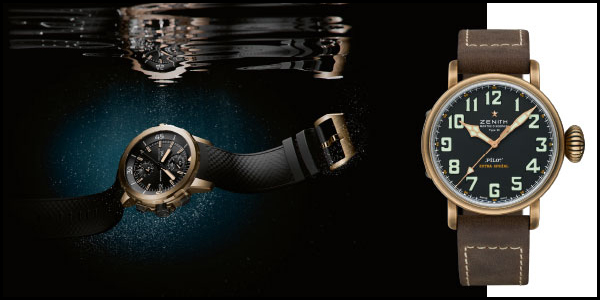
The Aquatimer Chronograph Edition “Charles Darwin Expedition” by IWC features a biocompatible titanium caseback.
Zenith Pilot Type 20 Extra Special : bronze also serves to create onboard instruments… for aircraft.
While not precious, rare or stainless, it still serves to make watch cases. Although bronze has none of the attributes required by watchmaking, it is nonetheless popular in this field. An alloy made of copper, zinc and sometimes other metals that help to refine its properties, bronze has been used for more than five thousand years… and a few centuries in the watch industry. It currently serves to make balance-wheels in a beryllium alloy called Glucydur. It dilates very little when subjected to heat and has thus acquired a special place within the movement. How has bronze come to adorn our watches ? By boat ! Bronze is the favored metal among ship chandlery manufacturers. Its high resistance to wear makes it an ideal material for metal deck elements such as rings, poles, shackles or hatches. It has quite logically established itself in the field of watches associated with the sea and in particular with scuba diving. While that may seem counter-intuitive, bronze has a special trick up its sleeve : while this metal is of course not stainless, it naturally acquires a fine and stable oxidized layer that protects it.

Urwerk has topped its UR105 T-Rex with a crisscross-engraved bezel forming a patinated breastplate.
It was at one point the most sought-after bronze watch on the market : the Panerai Luminor Submersible 1950 Bronzo PAM 382.
Variable
This paradox entails three advantages. The first is that the metal maintains its structural integrity, which means that it can be used for watch cases. The second is that bronze, being an alloy, features various colors according to its composition. It varies from a rosy yellow shade similar to 4N pink gold, to a warm grey or even a deep chestnut brown. Finally, this limited oxidation produces a marvelous effect in the form of a pleasing patina. Bronze is thus vibrantly alive. Its hue changes over time and according to the treatment undergone by its surface. This makes each watch unique upon closer inspection. And one can even work on its patina by hand, just as one would do with shoes.
Warm or dark
For most brands, and particularly pioneers such as Anonimo and Panerai, the choice tends to be a warm shade and a satin-brushed surface finish. The fine veins traced in the metal serve as tiny notches in which the oxidation takes up residence, making the appearance of the watch all the richer. Zenith has chosen a more distinctly yellow variation for its Pilot Type 20 Extra Special, similar to that chosen by IWC for its Aquatimer Chronograph Edition “Charles Darwin Expedition”. Urwerk has opted for a darker version similar to artwork bronze that has an even more powerful visual impact in that the bezel ‘shield’ covering the UR105 T-Rex is anything but smooth. Profoundly engraved like the scales of a giant saurian, it is lighter in the depths of the grooves than on its surface. It is however undoubtedly Bell&Ross that has pushed the patina to its ultimate conclusion. The BR01 Skull Bronze Tourbillon, the one-of-a-kind model presented for the Only Watch charity auction, is a full-on greenish-blue color, a unique effect that can be recreated with a bit of elbow grease and the appropriate oxidizing agent.

Anonimo interprets bronze in all its land- or sea-themed collections, including this Militare Chrono.
Oris pays tribute to the U.S. Navy’s first African American master diver with its Carl Brashear model.
Bell&Ross BR01 Skull Bronze, after intense work on its patina.
A word of caution
Despite all these advantages, the natural oxidation of bronze has a few less pleasant effects. The first is its odor. When imbibed with perspiration, a situation that can easily occur in summer, the watch starts to smell of oxidized metal. And since the shade varies, the color can actually bleed off. The wearer should thus avoid placing his damp watch in contact with a light-colored shirt, since the sleeves will stain. While the most worrying issue is that of allergies, this is easily remedied, since the backs of bronze cases are made of titanium. The latter is biocompatible and also makes the watches lighter, which is convenient in that bronze is 10% heavier than steel. The last feature to be aware of is temperature. Like titanium, bronze is a good conductor of heat and stores it up more readily than steel, which means your watch will feel warmer on the wrist in summer than steel models.






